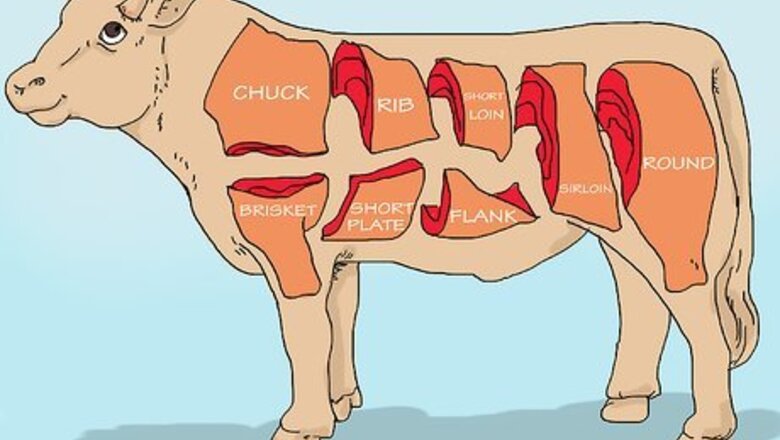
views
Types of Beef Cuts
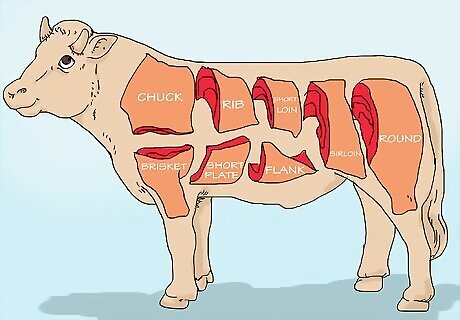
Identify the eight main cuts in which beef is available. These are loin, brisket, chuck, shank, round, short plate, flank and rib and are known as primal cuts. From these 8 main cuts there are many different minor beef cuts and are known as subprimal cuts. Retail beef is usually labeled with the primal and sub-primal information.
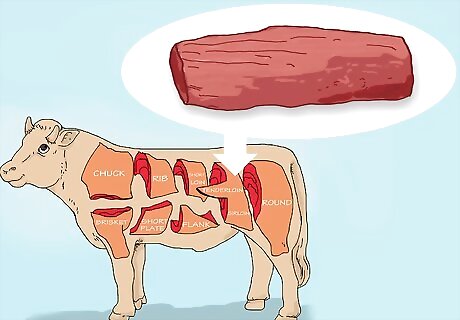
Choose loin for tender, flavorful beef. The loin is found on the top of the cow directly behind the rib. Loin is a very tender cut of beef without much marbling and can be cooked quickly without it toughening. This is because the loin is not a heavily used muscle and does not contain much connective tissue. Loin tends to be the most expensive cut of beef. Know the subprimal cuts from the loin. The loin can be divided into short loin and sirloin. The short loin yields more tender meat cuts than the sirloin, although both are still considered prized cuts. Some common cuts from the short loin area are tenderloin roast, filet mignon, T-bone steak, strip steak, strip roast, filet of strip, porterhouse steak and hanger steak. Some common cuts from the sirloin area are sirloin steak, center cut sirloin steak, tri-tip steak, tri-tip roast, filet of sirloin, coulotte steak, ball tip steak, ball tip roast and bottom sirloin.
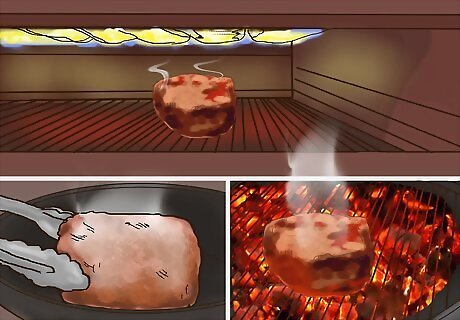
Know the best prepping and cooking methods for loin. Loin should be cooked with dry heat. This can be under a broiler, on a grill or in a pan. You want to avoid too much moisture when cooking loin because it may toughen the meat. The short loin area cooks well with thick and thin cuts of meat and will usually remain tender from rare to well done. The sirloin area will not handle too much heat and will begin to toughen when cooked well done. If cooking well, try to cut sirloin steak and other sirloin area beef, like tri-tip or coulotte, into thinner portions and do not overcook. Sirloin also cooks well when marinated prior to cooking.
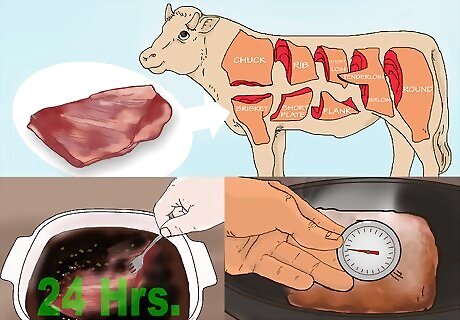
Choose brisket for long slow cooking. The brisket is the breast of the steer. It is a tough cut of meat, but tenderizes with slow cooking. It also contains a high amount of fat. Brisket is usually used for BBQ or deli meat. Know the subprimal cuts from the brisket. Brisket is usually sold whole and has very few subprimal cuts. A few subprimal cuts you may find are brisket flat or brisket point. The difference between the two being flat cut is a leaner cut of meat and a more flat, uniform cut of meat. Know the best prepping and cooking methods for brisket. Due to the toughness of brisket, it will benefit from a marinade or dry rub and moist cooking. A marinade can be applied up to 24 hours in advance. Brisket does well when brined before cooking as well because the salt helps create moisture pockets in the muscle. It also does well when smoked at low temperatures for a long period of time. Brisket should be cooked at lower temperatures for longer periods of time in order to minimize toughness. Cooking at a high temperature will make the connective tissue and fat tougher in brisket creating a chewy and dry cut of beef. The longer cooking allows the connective tissue and fat to dissolve into the meat giving it the moisture, tenderness and flavor desired.
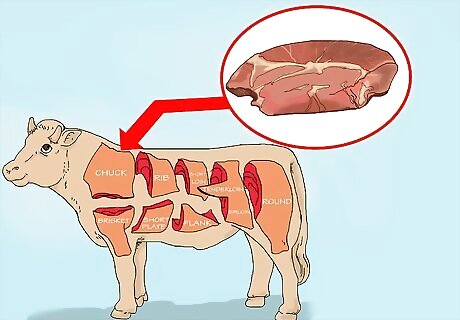
Choose chuck for a flavorful and cost effective cut of beef. Chuck meat comes from the shoulder of the cattle and is highly used. Because of the high use of this muscle, the meat has a lot of connective tissue creating a tough cut. However, chuck comes in many subprimal cuts and can be prepared in many ways that overcome this toughness. Know the subprimal cuts from the chuck. Chuck is sold ground or as whole muscle. Ground chuck is commonly used for hamburgers and other ground beef products. Some of the more tender cuts of chuck are flat iron steak, petite chuck tender roast and shoulder tender medallions. The other cuts of chuck tend to be tougher, but still very flavorful. They are top blade steak, chuck roast, cross rib roast, short ribs, stew meat, chuck arm roast, mock tender steak, shoulder clod roast, mock tender roast, ranch steak, sierra cut, under blade steak, country style ribs, chuck eye roast and chuck eye steak. Know the best prepping and cooking methods for chuck. Ground chuck cooks well grilled or pan fried without any prep work. Chuck roasts benefit the most from moist cooking at low temperatures for longer periods of time. Chuck roasts can be broiled, braised or cooked in a crock pot. The key to a tender and moist roast is low heat for a long period of time in order to dissolve the connective tissue. Stewing works well for whole muscle cuts of chuck. When cooking with chuck steaks, a marinade or tenderizer will help tenderize the meat and keep it moist for grilling or other shorter cooking methods. When marinating steaks, marinade for a shorter period of time, usually less than an hour. When choosing a chuck steak, select the thickness based on how you plan to cook it. For short cooking at higher temperatures a thinner steak will work well. For cooking in liquids or for longer periods of time a thicker steak will work well.
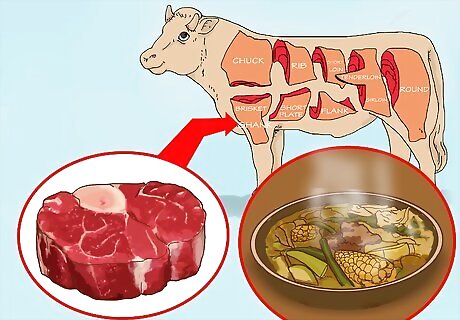
Choose shank for a hearty and flavorful cut of beef. Beef shank is found in front of the brisket and is the forearm of the cattle. This cut of meat contains a high amount of collagen and is used in many recipes that call for a gravy type of sauce. Know the subprimal cuts from the shank. Shank is usually sold whole with the bone in, but it can be ground for lean beef as well. Sometimes shank can be found in a crosscut with the brisket meat attached. Know the best prepping and cooking methods for shank. Shank has the best flavor when cooked with the bone in and should be cooked with moist heat. It benefits from long cooking at low heat. The collagen is released during cooking and will create a rich, creamy sauce. Shank is good for making soups and broths.
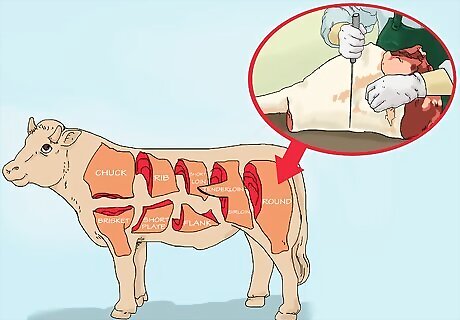
Choose round for an inexpensive cut of beef that goes well with many meal styles. The round is found on the back part of the cattle and includes the rump and hind leg. Round tends to be slightly tough due to the high use of the muscle and is considered a lean meat. Know the subprimal cuts from the round. Round is often sold as ground beef and will be labeled ground round. There are many subprimal roast cuts as well. These include rump roast, top round London broil, bottom round London broil, top round roast, eye of round roast, bottom round roast, sirloin tip roast and sirloin tip center roast. There are some steak cuts from the round as well. These include round petite tender steaks, top round steaks, bottom round steak, eye of round steak, sirloin tip center steak, sirloin tip side steak and butterfly top round steak.
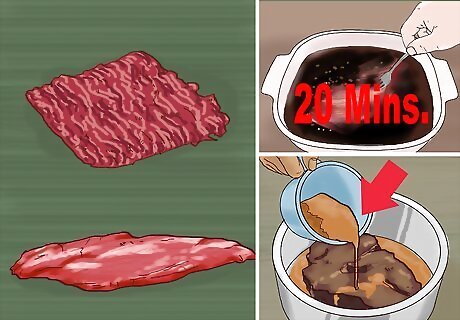
Know the best prepping and cooking methods for round. Ground round and petite tender steaks can be pan fried or grilled without marinating and turn out tender and flavorful. The roasts can be cooked in various ways. These are with moist heat, such as braising, or with dry heat, such as roasting. When roasting, lower temperatures with longer cooking times will give the roast the best flavor. The exception to cooking roasts is with London broil. London broil benefits the most from being marinated and grilled. Steaks from the round can be prepared in many ways. They all benefit from a marinade. After marinating, the steaks can be sautéed or grilled. Another good method for cooking round steaks is braising in a flavorful liquid and marinating is not required. When marinating round it is important that you do not over-marinate. Due to the leanness of the meat, over-marinating will toughen the proteins and give the opposite of the desired effect. When using a marinade, it is best to start with a shorter marinating time, such as 20 minutes at room temperature, and increase the time as needed.
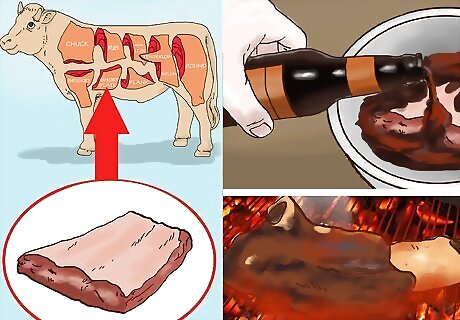
Choose short plate for short ribs or fajita meat. The short plate is found underneath the ribs near the abdomen area of the cattle. This cut contains some rib bones, cartilage and meat. It is not a lean cut of meat. Know the subprimal cuts from the short plate. Short ribs and skirt steak are the subprimal cuts from the short plate. The short ribs contain more cartilage than the skirt steak. Know the best prepping and cooking methods for short plate. For skirt steak and short ribs, removal of the membrane on one side is important before cooking. The membrane does not allow direct heat to penetrate the meat and will become chewy and tough when cooked. The skirt steak does well when cooked with dry heat, in a pan or on the grill. It needs high heat and searing to develop flavors and should not be cooked to well done. Once it is cooked, slice it across the grain very thin. Short ribs cook better with moist heat on lower temperatures at a longer time. They have a very full flavor and pair well with high flavor braising liquids, such as dark beer.
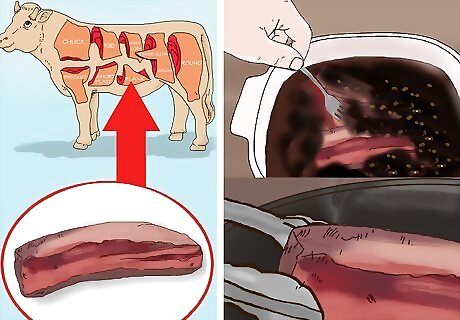
Choose flank for a flavorful cut of beef that can feed many people. The flank is on the underside of the cattle below the loin. Flank is a tough cut of beef. Know the subprimal cuts from the flank. The subprimal cuts are flank steak or flap. Flank steak is the most popular cut and can be easily found in most supermarkets. Know the best prepping and cooking methods for flank. Flank benefits from a marinade, usually no more than an hour. It can then be grilled, broiled or pan seared. Flank also benefits from braising.
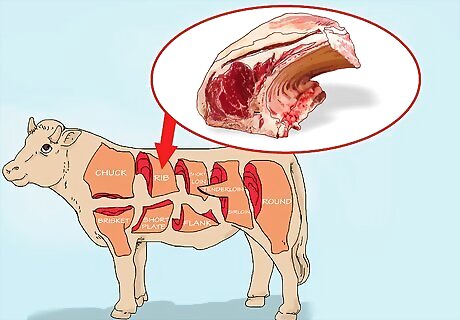
Choose rib for a tender cut of beef. The rib cut comes from the backbone and ribs of the cattle. It generally contains a high amount of marbling and is used to make steaks, roasts and ribs. Know the subprimal cuts from the rib. The steak cuts are Delmonico steak, filet of rib, cowboy steak, rib steak and ribeye steak. The roast cuts consist of prime ribeye roast and boneless ribeye roast. The cuts containing rib bones are back ribs and short ribs. Know the best prepping and cooking methods for rib. There is a lot of versatility when cooking cuts of beef from the rib. The backbone area produces the tenderest cuts and the ribs tend to be slightly tougher, but all the cuts are very flavorful. The steaks should be cooked with dry heat and can be sautéed, broiled or grilled. Depending on the thickness of the cut, they will cook quickly. Steaks from the rib are usually tender even when cooked well done due to the high amount of marbling. To get the best steak, look for good marbling before purchasing. Roasts from the rib cook well with dry heat. Before cooking the roast, pat it with a towel to remove excess moisture, season and then roast in an oven. Braising is not usually a good method for cooking a roast from the rib because it can toughen the meat. For the rib cuts braising is usually the best method because they do well with the extra moisture.
Purchasing Beef Cuts
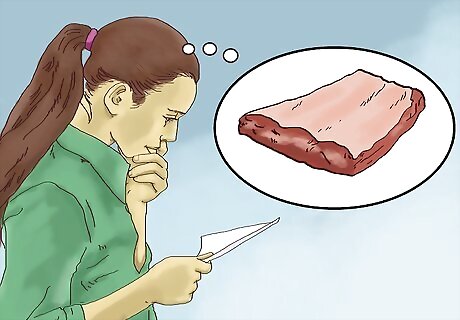
Know the quality indicators for purchasing beef. Most grocery stores carry quality beef. There are certain quality indicators to look for when purchasing beef and labeling information can be confusing. In order to avoid confusion it is best to have the cut you would like to purchase in mind before going shopping.
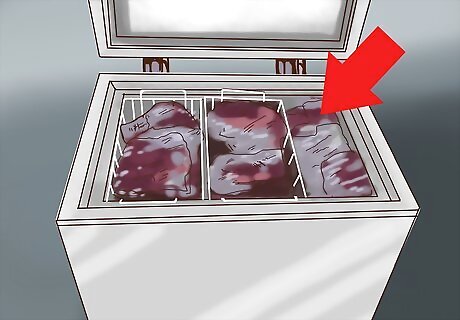
Be sure the meat is cold and stored in a cooler at the grocery store. You want the meat to be cold from the time it left the manufacturing plant to the time you purchase it in order to get the best quality with the least issue of bacterial contamination. If the meat does not feel cold to the touch in the store, you should not purchase it.
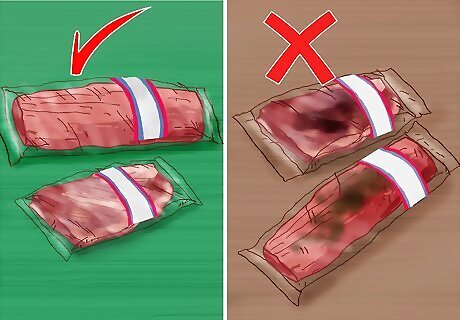
Check the color of the meat. It is best to purchase beef in clear packages so you can evaluate the color. It should be bright red or a purplish-red. There should not be any discolored spots, such as gray or brown. Often grocery stores will put beef on sale when it is close to expiration, so, in order to avoid purchasing lower quality beef, you will need to examine the beef for discoloration.
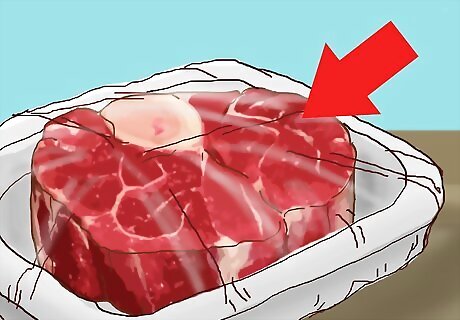
Evaluate the moisture level in the beef package. The fresher the beef is, the less free moisture there will be in the package. If there is an excess of water in the package, the meat may have been mishandled, stored at incorrect temperatures or close to expiration.
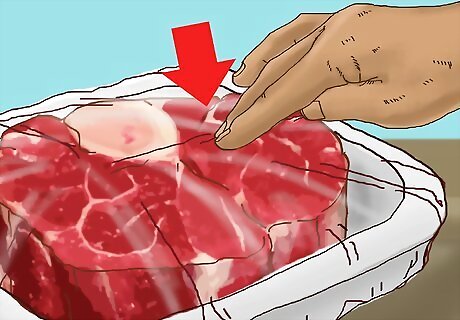
Choose beef that is not soft or mushy to the touch. Beef should be firm, with tougher or larger cuts of meat being more firm than tender or small cuts of beef.
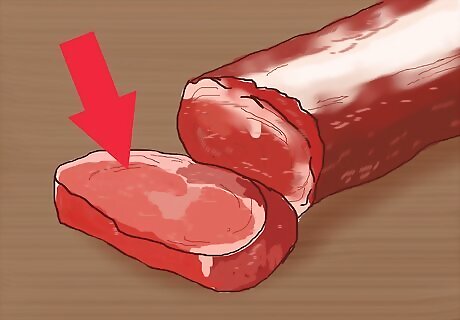
Select the appropriate thickness and cut. If the meat looks like it has a rough uneven cut, you probably do not want to purchase it. Beef will cook more evenly when it is cut to the same thickness throughout the piece. If it is uneven, then you may have some parts overcooked or undercooked. When purchasing steaks that need to be cooked well done in a shorter amount of time, a thinner cut is usually best.
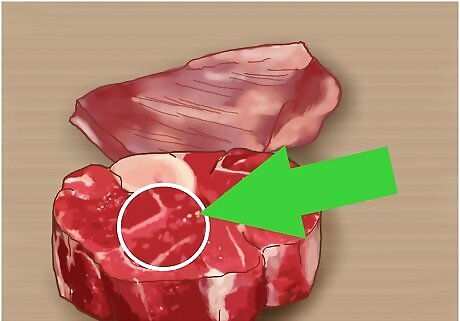
Get the appropriate amount of marbling and fat. For leaner cuts, such as eye of round or sirloin steak, choose beef with the least amount of marbling and visible fat. If you are cooking a higher fat cut or less tender cut, such as ribeye steak or chuck roast, then marbling and fat are important to the flavor. Marbling should be even throughout the meat without many large fat lines running through the meat. For roasts, having a layer of fat or larger fat lines can be beneficial to the flavor and tenderness after cooking because they will essentially “melt” into the meat.
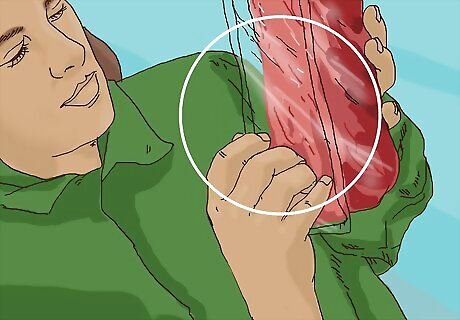
Check packaging carefully before purchase. The meat should be completely sealed with no holes or exposure to air. Vacuumed sealed beef is a purplish-red color when it is sealed and turns bright red after exposure to oxygen. If you are purchasing vacuum sealed meat and it is bright red before you open it, the package may have been compromised and you may not want to purchase. It is best to purchase in clear packages because you can see what you are getting. Sometimes ground beef is sold in packaged tubes. The ground beef is still fine to eat, but it may be a higher fat content or lower quality than ground beef in clear vacuumed sealed packages. It is still safe to eat as long as the package has not been compromised in any way. When purchasing beef from a butcher, be sure it is wrapped in sanitary packaging or paper and is sealed completely.
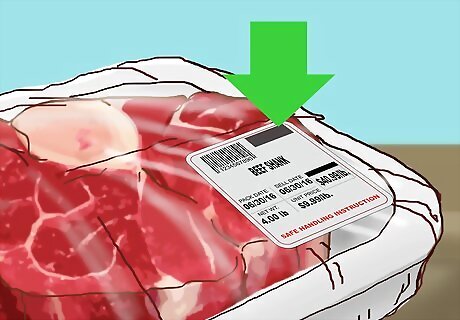
Understand labeling of beef cuts. Having beef that is labeled properly is important to understanding how to handle the beef and if it is right for your application. Choose meat that is clearly labeled with the primal and subprimal cut information. There are some subprimal cuts from different primal cuts that have the same name. Without knowing the primal cut information you may purchase the wrong subprimal cut of beef. Know what health claims are and which ones can be used with beef. Beef can be labeled with lean or extra lean health claims. In order to be considered lean, it must have less than 10 g of total fat, less than 4.5 g of saturated fat and less than 95 mg of cholesterol. In order to be considered extra lean, it must have less than 5 g of total fat, less than 2 g of saturated fat and less than 95 mg of cholesterol. Some packages of beef may have the American Heart Association (AH) check mark. This is not a health claim, but an endorsement from the AHA because the benefits of that cut of beef meet AHA heart healthy standards.
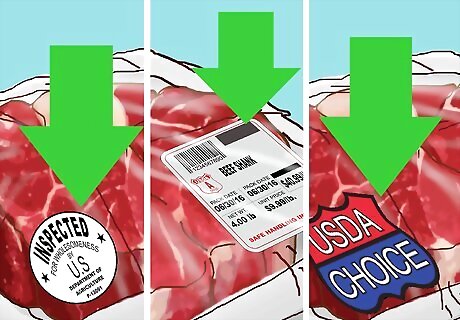
Understand the USDA grading system. USDA grading is not mandatory, but many companies pay to have the grading done to help consumers understand the difference in beef. Prime is the highest grade and is characterized by high marbling and tenderness. Choice is the next grade and is the most commonly sold grade. It has some marbling and tenderness varies. Select is lowest grade and applies to very lean cuts of beef. The grading system does not determine the overall quality of the meat, just the tenderness and amount of fat content.
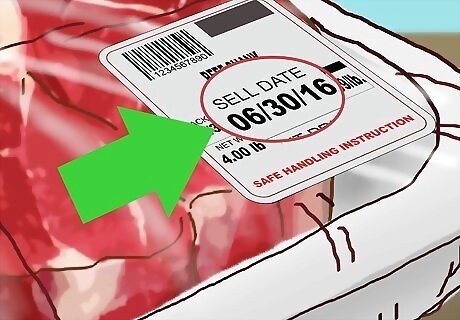
Be sure the meat purchased has a sell by date. Sell by dates can help you determine quality and how the meat should be stored. If it is close to the sell by date the meat may suffer from being frozen at this point and should probably be cooked with in a day of purchasing. If the meat is not close to the sell by date, then it should freeze well.
Storing Beef Safely
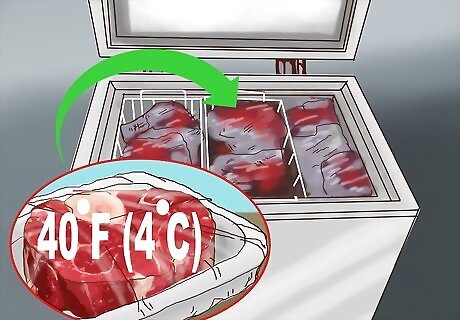
Purchase and store store beef cold, less than 40°F (4°C). Colder temperatures help hinder bacterial growth. If the meat gets too warm bacteria can grow on the surface and into the muscle tissue. Once bacteria have grown into the muscle tissue cooking may not kill it and it will make a person ill.
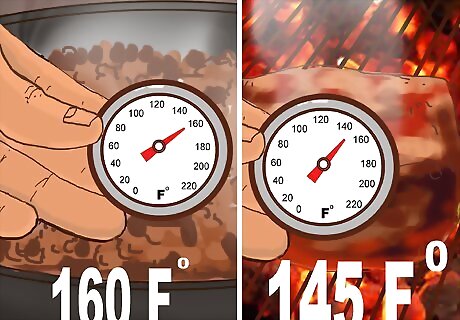
Cook all ground beef to an internal temperature of 160°F (70°C) and all other beef cuts to an internal temperature of 145°F (63°C). These specifications will help you cook enough to eliminate most risk of salmonella and other food poisoning.
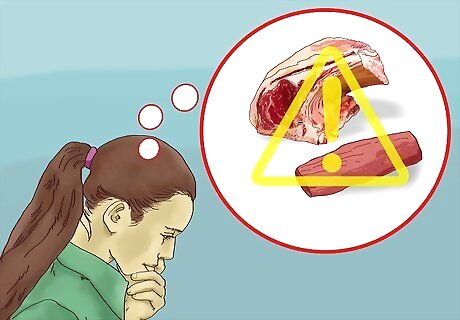
Know which cuts pose a higher risk for bacterial contamination. According to the National Institute of Health, Salmonella may be found more from loin, rib or chuck primal cuts. E.coli may be found more from the sirloin and round areas of the cattle. When purchasing these cuts of beef it is more important to ensure they were handled and stored properly before purchase and to handle and store them properly at home.


















Comments
0 comment